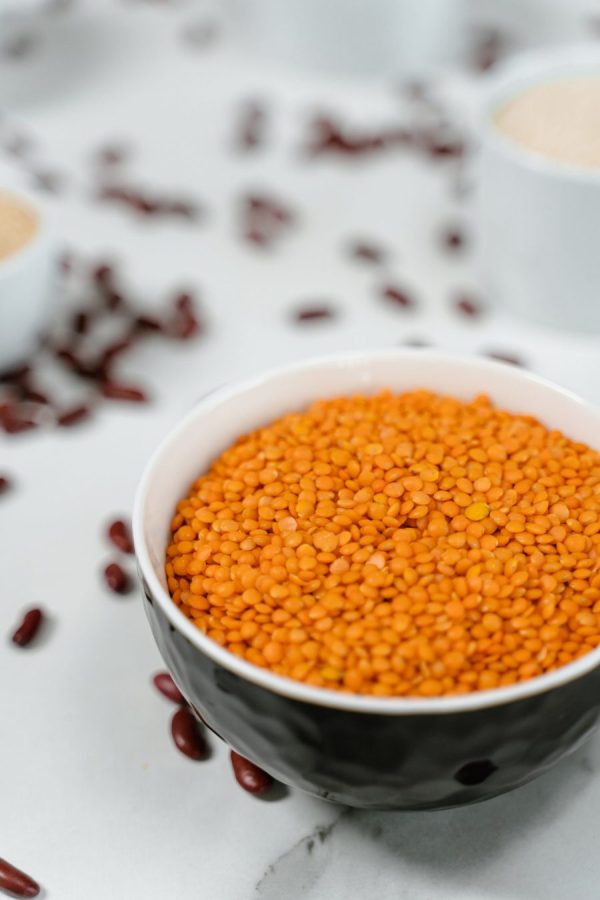Lentils are a nutritious ingredient that can be used in various dishes. They are an excellent source of protein, fibre, and other essential nutrients, making them a perfect option for vegetarians and vegans. Two easy ways to cook lentils are by simmering them in water or using a pressure cooker. The simmering method takes around 20-30 minutes, while using a pressure cooker takes only 10-15 minutes. Both methods result in perfectly cooked lentils every time.n dishes as a source of protein. Here’s what you need to know about lentils.
Types of Lentils
There are several types of lentils, each with its unique flavour and texture. Here are some of the most common types of lentils:
- Brown Lentils: These are the most common types of lentils and are often used in soups and stews. They have a mild flavour and hold their shape well when cooked.
- Green Lentils: These lentils have a slightly nutty flavour and hold their shape well when cooked. They are often used in salads and side dishes.
- Red Lentils: These lentils cook quickly and have a soft texture. They are often used in Indian and Middle Eastern dishes.
- French Lentils: Also known as Puy lentils, these are small and dark green. They hold their shape well when cooked and have a slightly peppery flavour.
Nutritional Value
Lentils are a great source of protein, fibre, and complex carbohydrates. They are also low in fat and calories. Here are some of the key nutrients found in lentils:
- Protein: Lentils are a great source of plant-based protein, with about 18 grams of protein per cup.
- Fibre: Lentils are high in fibre, which can help promote digestive health and keep you feeling full.
- Iron: Lentils are a good source of iron, which is important for transporting oxygen throughout the body.
- Folate: Lentils are high in folate, which is important for healthy fetal development during pregnancy.
Overall, lentils are a nutritious and versatile ingredient that can be used in a variety of dishes.
Preparation Before Cooking
Before cooking lentils, there are a few steps that should be taken to ensure they are clean and ready to cook.
Sorting and Rinsing
The first step in preparing lentils is to sort them. This involves going through the lentils and removing any debris such as small stones or twigs. This is important because these foreign objects can be harmful if ingested.
After sorting, the lentils should be rinsed thoroughly with cool water. This will remove any dirt or dust that may be on the lentils.
Soaking
Soaking lentils is not necessary, but it can help to reduce cooking time and make them easier to digest. To soak lentils, place them in a bowl and cover them with water. Let them soak for at least 30 minutes, or up to 4 hours.
After soaking, drain the water and rinse the lentils again before cooking.
Taking these steps before cooking lentils can help to ensure that they are clean, safe to eat, and easier to digest.
Related
Cooking Methods
Lentils are a versatile and nutritious legume that can be cooked in a variety of ways. Here are three popular methods for cooking lentils:
Stovetop Cooking
Stovetop cooking is the most common method for cooking lentils. To cook lentils on the stovetop, follow these steps:
- Rinse the lentils in a fine-mesh strainer under cold running water.
- Add the lentils to a pot and cover with water or broth.
- Bring the water to a boil, then reduce the heat to low and simmer for 20-30 minutes or until the lentils are tender.
- Drain any excess water and season the lentils with salt and pepper to taste.
Pressure Cooking
Pressure cooking is a faster method for cooking lentils. To pressure-cook lentils, follow these steps:
- Rinse the lentils in a fine-mesh strainer under cold running water.
- Add the lentils and water or broth to a pressure cooker.
- Close the lid and set the pressure cooker to high pressure.
- Cook for 8-10 minutes, then release the pressure manually.
- Drain any excess water and season the lentils with salt and pepper to taste.
Slow Cooking
Slow cooking is a convenient method for cooking lentils that requires minimal effort. To slow-cook lentils, follow these steps:
- Rinse the lentils in a fine-mesh strainer under cold running water.
- Add the lentils and water or broth to a slow cooker.
- Cook on low for 6-8 hours or on high for 3-4 hours.
- Drain any excess water and season the lentils with salt and pepper to taste.
These three methods are all effective for cooking lentils and can be adapted to suit your preferences and cooking style.
Seasoning and Serving Ideas
Herbs and Spices
Adding herbs and spices is an easy way to add flavour to lentils. Here are a few ideas to get started:
- Cumin: Toast cumin seeds in a dry pan, then grind them and sprinkle over cooked lentils.
- Coriander: Add ground coriander to the lentils while they cook.
- Turmeric: Add a pinch of turmeric to the lentils while they cook for a vibrant yellow colour.
- Rosemary: Add a sprig of fresh rosemary to the lentils while they cook. Remove before serving.
- Thyme: Add a few sprigs of fresh thyme to the lentils while they cook. Remove before serving.
Serving Suggestions
Lentils can be served in many ways. Here are a few ideas:
- Over rice: Serve lentils over rice for a complete meal.
- In a wrap: Spread hummus on a wrap, then add cooked lentils, chopped vegetables, and a drizzle of tahini.
- In a salad: Add cooked lentils to a salad for extra protein.
- As a dip: Puree cooked lentils with garlic, lemon juice, and olive oil for a flavorful dip.
- As a side: Serve lentils as a side dish with grilled chicken or fish.
Experiment with different herbs, spices, and serving ideas to find your favourite way to enjoy lentils.
Storing and Reheating Lentils
Refrigeration
To store cooked lentils, place them in an airtight container and keep them in the refrigerator. Cooked lentils can last up to five days in the fridge. When reheating, add a splash of water or broth to prevent them from drying out. Lentils can be reheated in the microwave or on the stove.
Freezing
Cooked lentils can also be frozen for future use. Allow them to cool completely before placing them in a freezer-safe container. Lentils can be frozen for up to six months. To thaw, place the container in the refrigerator overnight. Reheat lentils on the stove or in the microwave with a splash of water or broth.
Remember to label the container with the date and contents to keep track of when they were made. Lentils can be a great addition to any meal, and storing and reheating them properly can make meal prep a breeze.

